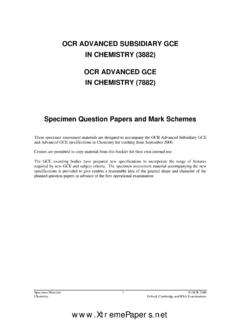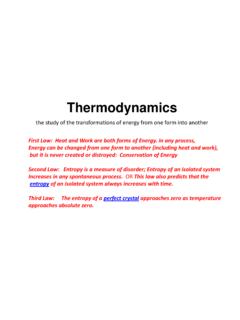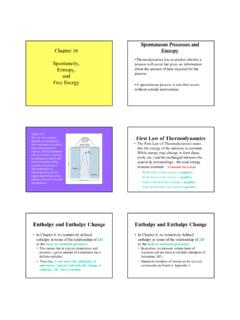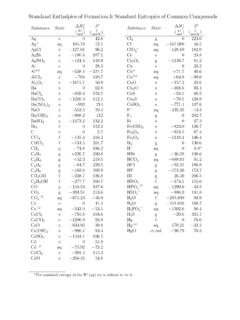Transcription of © www.CHEMSHEETS.co.uk 10-Mar-2016 Chemsheets A2 …
1 10-Mar-2016 Chemsheets A2 1014 Page 1 10-Mar-2016 Chemsheets A2 1014 Page 2 SECTION 1 Recap of AS Energetics 1) What is enthalpy? What is enthalpy? It is a measure of the heat content of a substance Enthalpy change ( H) = Change in heat content at constant pressure Standard conditions ( H ) = 100 kPa and a stated temperature [Note that the symbol for standard conditions should be a circle with a horizontal line through it, but it is safer here to put a circle with no line as otherwise the character that may appear on the computer the document is from may substitute some random symbol!]
2 ] 2) Reaction profiles Exothermic reactions Endothermic reactions 3) Standard enthalpy change of reaction ( rH ) ( enthalpy of reaction ) This is the enthalpy change for a reaction with the quantities shown in the chemical equation. This means that the value should always be quoted along with the equation. In this example, the second equation contains half the molar quantities of the first and so the rH value is half as much. H2SO4(aq) + 2 NaOH(aq) Na2SO4(aq) + 2 H2O(l) rH = kJ mol-1 H2SO4(aq) + NaOH(aq) Na2SO4(aq) + H2O(l) rH = kJ mol-1 the value of kJ mol-1 in the first equation means that kJ of heat energy is released when 1 mole of H2SO4 reacts with 2 moles of NaOH.
3 The value of kJ mol-1 in the second equation means that kJ of heat energy is released when mole of H2SO4 reacts with 1 mole of NaOH. 10-Mar-2016 Chemsheets A2 1014 Page 3 4) Standard enthalpy change of formation ( fH ) ( enthalpy of formation ) Enthalpy change when 1 mole of a substance is formed from its constituent elements with all reactants and products in standard states under standard conditions. CH4(g) .. H2O(l) .. NH3(g) .. C2H5OH(l) .. CH3Br(l) .. Na2O(s) .. Note: re fH of an element in its standard state = 0 by definition 5) Standard enthalpy change of combustion ( cH ) ( enthalpy of combustion ) Enthalpy change when 1 mole of a substance is completely burned in oxygen with all reactants and products in standard states under standard conditions.
4 CH4(g) .. H2(g) .. C2H6(g) .. C2H5OH(l) .. Na(s) .. C6H14(l) .. 6) Standard enthalpy change of neutralisation ( neutH ) ( enthalpy of neutralisation ) Enthalpy change when 1 mole of water is formed in a reaction between an acid and alkali under standard conditions. HCl(aq) + NaOH(aq) .. H2SO4(aq) + NaOH(aq) .. HNO3(aq) + KOH(aq) .. HNO3(aq) + Ba(OH)2(aq) .. H2SO4(aq) + Ba(OH)2(aq).. 10-Mar-2016 Chemsheets A2 1014 Page 4 Hess s Law Calculations The enthalpy change for a reaction is independent of the route taken the enthalpy change to go from A B direct is the same as going from A C B 1) Calculations involving enthalpies of formation ( Type 1 questions ) If the enthalpy of formation for the reactants and products in a reaction are known, the overall enthalpy change is easy to calculate.
5 H = [SUM of fH products] [SUM fH reactants] Remember that fH of all elements in their standard states is zero. Watch for the very frequent mistake of doing reactants products, rather than products reactants. If the overall enthalpy change for a reaction is known along with the enthalpy of formation of all but one of the reactants/products, then this equation can be used to find the missing enthalpy of formation . Example 1 Calculate the overall enthalpy change for this reaction given the data that follows: CH4(g) + 2 O2(g) CO2(g) + 2 H2O(l) fH CH4(g) = 75, CO2(g) = 394, H2O(l) = 286 kJ/mol.
6 Example 2 The enthalpy change for the following reaction is 2877 kJ/mol: C4H10(g) + 6 O2(g) 4 CO2(g) + 5 H2O(l) Calculate the enthalpy change of formation of butane (C4H10(g)) given the following data: fH CO2(g) = 394, H2O(l) = 286 kJ/mol .. A B C 10-Mar-2016 Chemsheets A2 1014 Page 5 2) Calculations involving enthalpies of combustion ( Type 2 questions ) Questions that involve enthalpies of combustion can usually be done using the cycle shown. The reaction involved across the top is often an enthalpy of formation (from elements to a compound). The sum of the clockwise arrows equals the sum of the anticlockwise arrows.
7 Be careful when drawing your cycle to ensure that arrows are going in the right direction and the number of moles is correct. If you use a cycle like this, there is no need to worry about getting the number of oxygen molecules in the downward arrows. reactants products oxides DH DcH DcH Example 1 Calculate the enthalpy change for this reaction given the following data. C(s) + 2 H2(g) CH4(g) cH C(s) = 394, H2(g) = 286, CH4(g) = 890 kJ/mol .. Example 2 Calculate the enthalpy of combustion of ethanol (C2H5OH) given the following enthalpy changes. cH C(s) = 393, H2(g) = 286 kJ/mol fH C2H5OH(l) = 75 kJ/mol.
8 10-Mar-2016 Chemsheets A2 1014 Page 6 3) Calculations involving bond enthalpies ( Type 3 questions ) Bond enthalpy is the enthalpy change to break one mole of covalent bonds in the gas phase. For most bonds ( C-H, C-C, C=O, O-H, etc.) the value for the bond enthalpy is an average taken from a range of molecules as the exact value varies from compound to compound. For some bond enthalpies ( H-H, H-Cl, O=O, etc) the value is exact as only one molecule contains that bond. Mean bond enthalpy is the enthalpy change to break one mole of covalent bonds in the gas phase averaged over several compounds.
9 enthalpies of reaction that have been calculated using mean bond enthalpies are not as accurate as they might be because the values used are averages and not the specific ones for that compound. The following cycle works for any question that involves bond enthalpies , whether to find a bond enthalpy or H for a reaction. Remember that substances must be in the gas state before bonds are broken, and so H to go to the gas state is needed for solids and liquids. (Note - H vaporisation is the enthalpy change to convert a liquid to a gas) As with other cycles, the sum of the clockwise arrows equals the sum of the anticlockwise arrows.
10 Be careful to ensure that arrow directions and number of moles are correct. reactants products gas atoms H ( H gas) + bond enthalpies ( H gas) + bond enthalpies Example 1 Hydrazine has the formula N2H4 and is used as a rocket fuel ( for the Apollo moon rockets). It burns in the following reaction for which the enthalpy change is 583 kJ/mol. N2H4(g) + O2(g) N2(g) + 2 H2O(g) Calculate the N-N bond enthalpy in hydrazine given the following bond enthalpies . Bond enthalpies : N-H 388, O=O 498, N N 944, O-H 463 kJ/mol .. 10-Mar-2016 Chemsheets A2 1014 Page 7 Example 2 Ethanol has the formula C2H5OH and is used as a fuel ( for cars in Brazil).







